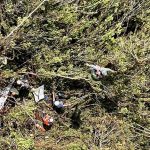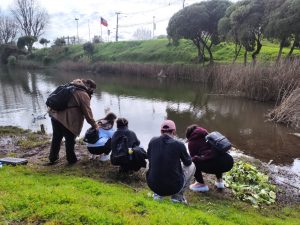The activity included taking soil and water samples from the Lo Méndez lagoon, where the third-year students were able to engage in a practical activity and subsequent laboratory analysis.
In 2020, the students who are currently in their third year of Environmental Chemistry at the Universidad Católica de la Santísima Concepción (UCSC), entered the career. In a pandemic context and with digital classes, it took time to be able to complement theory with practice. In this context, together with Microbiology professor Dr. Carolina Quezada, they carried out an activity in the field, specifically in the Lo Méndez lagoon, which included taking soil and water samples to observe which bacteria grow there.
After taking samples, the students entered the laboratories of the Faculty of Sciences UCSC, for the procedures that allow the isolation of microorganisms from the samples obtained. The idea is to be able to isolate bacteria from the samples so that they can be seen under microscopes. “These samples will be processed throughout the semester. We did a culture of these samples, to get an idea of what bacteria grow and see how many of them are resistant to commonly used antibiotics”, explained the academic.
Exit to terrain
The activity considers the observation and analysis of these bacteria in the following classes, calculating growth kinetics, staining to visualize different structures under a microscope and observing different aspects of their metabolism. In addition to knowing the information of the place, the academic assures that this material has potential for future research on biotechnological applications that can be carried out with the bacteria isolated from the place.
For Bastián Cepeda, a UCSC Environmental Chemistry student, the field was a significant experience for his training, considering that for a long time he had classes digitally. “We took soil and water samples to compare different aspects of the bacteria grown from both samples and to observe their diverse physiology. We also had to ask ourselves why more or less bacteria grow in the different samples, and why some may be resistant to Ampicillin, for example”, commented the student.
What the teacher highlights the most is related to the enthusiasm of the students when facing challenges in the field. “I think they received the activity very well and, furthermore, it was noted in the reports they wrote that they were very motivated, it was a good way to rediscover them in person and the challenges that an education in contact with nature implies,” said the teacher.
For the analyses, different environmental parameters of the place were recorded, including the pH and temperature of the water. As for the soil, they dug about 10 centimeters to obtain samples of bacteria that were not in direct contact with the surface.
“Analyzing samples in the laboratory was quite a new experience. We resuspend the soil samples in culture media and take small samples to plant them in media where bacteria can develop in the presence of nutrients and are visible. Subsequently, analyzes of different enzymatic reactions of the grown bacterial colonies could be carried out”, added Bastián Cepeda, evidencing the enthusiasm of both him and his colleagues.
It should be noted that throughout the course, students will make different reports that show the evolution of the sampling and the bacteria obtained, and thus have increasingly precise information on the bacteria found and their characterization to evaluate possible investigations. future that can be done with them.












![[Img #74798]](https://thelatestnews.world/wp-content/uploads/2025/01/Kurt-Godel-The-mathematician-who-challenged-the-foundations-of-logic-300x200.jpg)